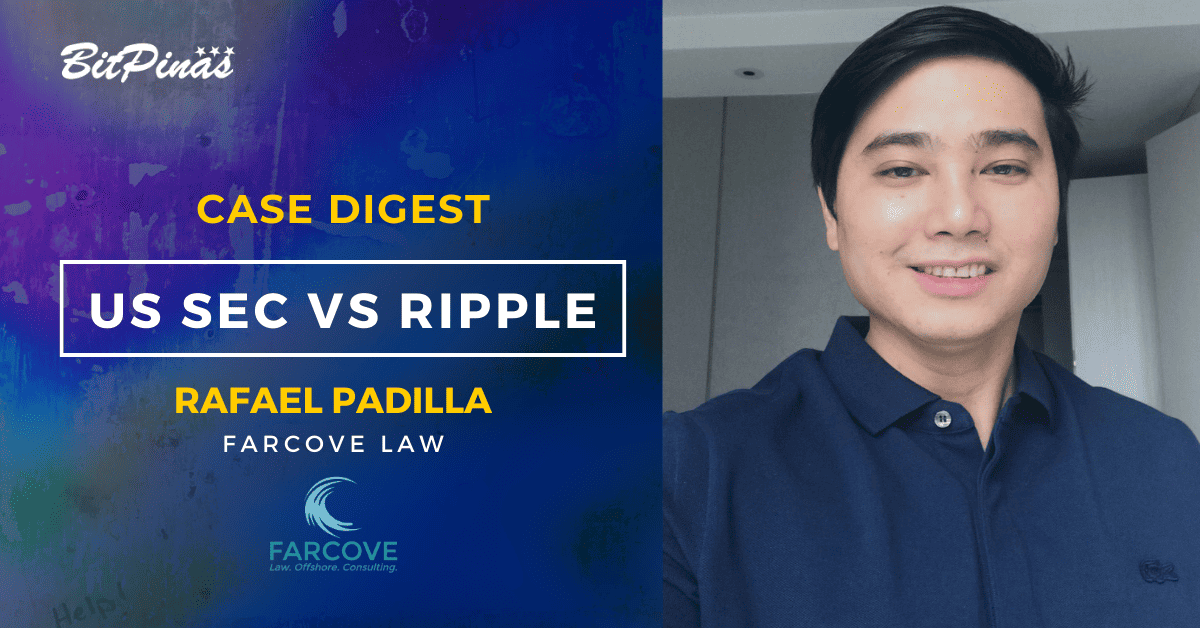Case Digest: US SEC v. Ripple
Atty. Rafael Padilla discussed in-depth the results of the US SEC vs Ripple decision. A recommended read for everyone following the case.

In this paper, Atty. Rafael Padilla, Co-Founder and Trustee of BlockDevs Asia, Professor of Law at San Beda Alabang, and author of Fintech: Law and First Principles, digested the US SEC vs Ripple decision, the results, and the implications. This is recommended read for everyone following the Ripple case.
Find more papers of Atty. Rafael Padilla on BitPinas:
- Decentralized and Decarbonized: Regulating Bitcoin Mining Through Lex Mercatoria
- Lodicoin, Meet Securities Law
- Who Should Regulate VASPs in the Philippines?
- Free Money: The Constitutional Aspects of Cryptocurrencies
- Insights on BSP Guidelines for Virtual Asset Service Providers by Atty. Rafael Padilla
Case Digest: SEC v. Ripple
(Southern District Court of New York, Case 1:20-cv-10832-AT-SN, 13 July 2023)
Parties
Plaintiff: United States Securities and Exchange Commission (SEC)
Defendants: Ripple Labs, Inc. (Ripple), Bradley Garlinghouse & Christian Larsen
Facts
In 2011 and early 2012, McCaleb, Britto, and Schwartz developed the source code for a cryptographically secured ledger, which is now known as the XRP Ledger, aiming to create a faster, cheaper, and more energy-efficient alternative to the Bitcoin network. When the XRP Ledger launched in 2012, its source code generated a fixed supply of 100 billion XRP. XRP is the native digital token of the XRP Ledger, and the XRP Ledger requires XRP to operate. Each unit of XRP is divisible into one million fungible “drops.”[1]
In 2012, Defendant Larsen, McCaleb, and Britto founded Ripple. Larsen became Ripple’s CEO, a position he held until December 2016. Of the 100 billion XRP generated by the XRP Ledger’s code, the three founders retained 20 billion for themselves (including 9 billion for Larsen) and provided 80 billion XRP to Ripple.[2]
Since its founding, Ripple’s mission has been to realize an “Internet of Value” by using technology to facilitate the transfer of value across the internet. Specifically, Ripple seeks to modernize international payments by developing a global payments network for international currency transfers. Ripple developed RippleNet, which allows customers to clear and settle cross-border financial transactions. On Demand Liquidity (ODL), a feature of RippleNet, facilitates cross-border transactions by allowing customers to exchange fiat currency for XRP and then the XRP for another fiat currency.[3]
The XRP Ledger is an open-source software; anyone can use the ledger, submit transactions, host a node to contribute to the validation of transactions, propose changes to the source code, or develop applications that run on the ledger. Ripple has also funded companies as part of its Xpring initiative to incentivize the development of other use cases on the XRP Ledger. Other developers have built software products that use the XRP Ledger, such as payment-processing applications.[4]
Since 2013, Ripple engaged in various sales and distributions of XRP. First, Ripple, through wholly owned subsidiaries, sold XRP directly to certain counterparties (primarily institutional buyers, hedge funds, and ODL customers) pursuant to written contracts (“Institutional Sales”). Second, Ripple sold XRP on digital asset exchanges “programmatically,” or through the use of trading algorithms (“Programmatic Sales”). Ripple’s XRP sales on these digital asset exchanges were blind bid/ask transactions, i.e., Ripple did not know who was buying the XRP, and the purchasers did not know who was selling it. Ripple used the proceeds from the Institutional and Programmatic Sales to fund its operations.[5]
Ripple also distributed XRP as a form of payment for services (“Other Distributions”). For instance, Ripple distributed XRP to its employees as a form of compensation. Ripple also distributed XRP in conjunction with its Xpring initiative to fund third parties that would develop new applications for XRP and the XRP Ledger.6
Aside from Ripple’s sales and distributions, Larsen and Defendant Garlinghouse (Chief Executive Officer) offered and sold XRP in their individual capacities. After stepping down as CEO of Ripple in December 2016, Larsen became the Executive Chairman of Ripple’s Board of Directors, a position he currently holds. From 2013 to 2020, Larsen sold XRP on digital asset exchanges programmatically and made at least $450 million from his sales.[6]
The SEC alleges that Defendants sold XRP as an investment contract and thus a security. The SEC alleges that Ripple engaged in three categories of unregistered XRP offers and sales:
(1) Institutional Sales under written contracts for which it received $728 million;
(2) Programmatic Sales on digital asset exchanges for which it received $757 million; and
(3) Other Distributions under written contracts for which it recorded $609 million in “consideration other than cash.” [7]
Defendants did not file a registration statement as to any offers or sales of XRP, arguing that they did not sell XRP as an investment contract, and, therefore, no registration statement was required.[8] Defendants further argued that the SEC violated their due process rights; invoking fair notice defense and as-applied vagueness defense.
Both parties’ filed cross-motions for summary judgment, arguing that there is no genuine dispute as to any material facts of the case.
Main Issue
Whether Defendants offered to sell or sold XRP as a security.
Rulings
- Ripple’s Institutional Sales of XRP constituted an unregistered offer and sale of investment contracts in violation of federal securities law.15
- Ripple’s Programmatic Sales of XRP did not constitute the offer and sale of investment contracts.[9]
- Ripple’s Other Distributions did not constitute the offer and sale of investment contracts.[10]
- Larsen’s and Garlinghouse’s offer and sale of XRP on digital asset exchanges did not amount to offers and sales of investment contracts.[11]
- Defendants’ fair notice defense and as-applied vagueness defense were dismissed.
- The SEC’s motion for summary judgment on the aiding and abetting claim against Larsen and Garlinghouse was denied.
Discussions
Merits of summary judgment
The respective motions for summary judgment of the SEC and Ripple were partially granted. Summary judgment is appropriate where the record shows that there is no genuine dispute as to any material fact and that the moving party is entitled to judgment as a matter of law. A genuine dispute exists if the evidence is such that a reasonable jury could decide the case in favor of the nonmoving party. The moving party bears the burden of demonstrating the absence of a genuine dispute of material fact by citing evidence in the record.
Howey test
SEC v. W.J. Howey Co. held that an investment contract is “a contract, transaction, or scheme whereby a person (1) invests his money (2) in a common enterprise and (3) is led to expect profits from the efforts of the promoter or a third party. In analyzing whether a contract, transaction, or scheme is an investment contract, form should be disregarded for substance and the emphasis should be on economic reality and the totality of circumstances. The Howey test reflects a focus on an investor’s expectation of profits from the efforts of others, rather than the formal imposition of post-sale obligations on the promoter. The word “profits” in Howey was intended to refer to “income or return,” and financial returns on investments are not equivalent to post-sale obligations.[12]
The Howey test was intended to embody a flexible rather than a static principle, one that is capable of adaptation to meet the countless and variable schemes devised by those who seek to use the money of others on the promise of profits, guided by the fundamental purpose in which Congress “painted with a broad brush” in recognition of the virtually limitless scope of human ingenuity. The Howey test was intended to effectuate the statutory policy of affording broad protection to investors, protection that is not to be thwarted by unrealistic and irrelevant formulae.[13]
The plain words of Howey make clear that an investment contract means a contract, transaction, or scheme. But the subject of a contract, transaction, or scheme is not necessarily a security on its face. Under Howey, the Court analyzes the economic reality and totality of circumstances surrounding the offers and sales of the underlying asset.[14]
Howey and the succeeding cases that applied the Howey test have held that a variety of tangible and intangible assets can serve as the subject of an investment contract.[15] In these cases, the subject of the investment contract was a standalone commodity, which was not itself inherently an investment contract. For instance, if the original citrus groves in Howey were later resold, those resales may or may not constitute investment contracts, depending on the totality of circumstances surrounding the later transaction.[16]
Ordinary assets—like gold, silver, and sugar—may be sold as investment contracts, depending on the circumstances of those sales. Plenty of items that can be consumed or used have been the subject of transactions determined to be securities because they had the attributes of an investment. Even if XRP exhibits certain characteristics of a commodity or a currency, it may nonetheless be offered or sold as an investment contract.[17]
XRP, as a digital token, is not in and of itself a contract, transaction, or scheme that embodies the Howey requirements of an investment contract. Rather, the totality of circumstances surrounding Defendants’ different transactions and schemes involving the sale and distribution of XRP must be examined.[18] Each transaction must be analyzed and evaluated on the basis of the content of the instruments in question, the purposes intended to be served, and the factual setting as a whole.[19]
Institutional Sales
The Institutional Buyers invested money by providing fiat or other currency in exchange for XRP. The proper inquiry is whether the Institutional Buyers “provided the capital,”[20] “put up their money,”[21] or “provide(d) cash.”[22] Defendants did not dispute that there was a payment of money; therefore, the investment of money prong has been established.[23]
The second prong of Howey, the existence of a common enterprise may be demonstrated through a showing of horizontal commonality. Horizontal commonality exists where the investors’ assets are pooled and the fortunes of each investor are tied to the fortunes of other investors, as well as to the success of the overall enterprise. Horizontal commonality is a type of commonality that involves the pooling of assets from multiple investors so that all share in the profits and risks of the enterprise.12 Ripple pooled the proceeds of its Institutional Sales into a network of bank accounts under the names of its various subsidiaries. Although Ripple maintained separate bank accounts for each subsidiary, Ripple controlled all of the accounts and used the funds raised from the Institutional Sales to finance its operations. Ripple did not segregate and separately manage investor funds or allow for profits to remain independent. In fact, Ripple’s accountants recorded all of its XRP-related proceeds together.
Each Institutional Buyer’s ability to profit was tied to Ripple’s fortunes and the fortunes of other Institutional Buyers because all Institutional Buyers received the same fungible XRP.13 Ripple used the funds it received from its Institutional Sales to promote and increase the value of XRP by developing uses for XRP and protecting the XRP trading market. When the value of XRP rose, all Institutional Buyers profited in proportion to their XRP holdings.[24] Common enterprise existed because there was a pooling of assets and that the fortunes of the Institutional Buyers were tied to the success of the enterprise as well as to the success of other Institutional Buyers.[25]
The third prong of Howey examines whether the economic reality surrounding Ripple’s Institutional Sales led the Institutional Buyers to have a reasonable expectation of profits to be derived from the entrepreneurial or managerial efforts of others.14 In this context, “profit” means an income or return, such as dividends, other periodic payments, or the increased value of the investment. The reasonable expectation of profits from the efforts of others need not be the sole reason a purchaser buys an investment; an asset may be sold for both consumptive and speculative uses. Moreover, the inquiry is an objective one focusing on the promises and offers made to investors; it is not a search for the precise motivation of each individual participant.[26]
Based on the totality of circumstances, the reasonable investors, situated in the position of the Institutional Buyers, would have purchased XRP with the expectation that they would derive profits from Ripple’s efforts. From Ripple’s communications, marketing campaign, and the nature of the Institutional Sales, reasonable investors would understand that Ripple would use the capital received from its Institutional Sales to improve the market for XRP and develop uses for the XRP Ledger, thereby increasing the value of XRP.
Since 2013, Ripple marketed XRP to potential investors, including the Institutional Buyers, by distributing promotional brochures that touted XRP as an investment tied to the company’s success. For example, in the “Deep Dive” brochure, which was circulated to prospective investors, Ripple explains that its “business model is predicated on a belief that demand for XRP will increase if the Ripple protocol becomes widely adopted, and if the Ripple protocol becomes the backbone of global value transfer, Ripple expects the demand for XRP to be considerable.” Similarly, the “Ripple Primer” states that Ripple “hopes to make money from XRP if the world finds the Ripple network useful. [27] In July 2017, Schwartz (Chief Technology Officer) wrote on Reddit that, “Ripple can justify spending $100 million on a project if it could reasonably be expected to increase the price of XRP by one penny over the long term.” In November 2017, Schwartz posted on an online forum, XRP Chat, that Ripple would use its “war chest” to put upward pressure on XRP’s price. These statements are representative of Ripple’s overall messaging to the Institutional Buyers about the investment potential of XRP and its relationship to Defendants’ efforts. The Institutional Buyers would have understood that Ripple was pitching a speculative value proposition for XRP with potential profits to be derived from Ripple’s entrepreneurial and managerial efforts.[28]
Further, the nature of the Institutional Sales also supports the conclusion that Ripple sold XRP as an investment rather than for consumptive use. In their sales contracts, some Institutional Buyers agreed to lockup provisions or resale restrictions based on XRP’s trading volume. These restrictions are inconsistent with the notion that XRP was used as a currency or for some other consumptive use. As observed in the Telegram case, “(s)imply put, a rational economic actor would not agree to freeze millions of dollars xxx if the purchaser’s intent was to obtain a substitute for fiat currency.”[29] Other contracts expressly stated that the Institutional Buyer was purchasing XRP “solely to resell or otherwise distribute xxx and not to use (XRP) as an (e)nd (u)ser or for any other purpose.” These various provisions in the Institutional Sales contracts support the conclusion that the parties did not view the XRP sale as a sale of a commodity or a currency; they understood the sale of XRP to be an investment in Ripple’s efforts.”[30]
Programmatic Sales
The SEC alleged that in the Programmatic Sales to public buyers (“Programmatic Buyers”) on digital asset exchanges, “Ripple understood that people were speculating on XRP as an investment,” “explicitly targeted speculators, and made increased speculative volume a target goal.”[31]
Whereas the Institutional Buyers reasonably expected that Ripple would use the capital it received from its sales to improve the XRP ecosystem and thereby increase the price of XRP, Programmatic Buyers could not reasonably expect the same. Indeed, Ripple’s Programmatic Sales were blind bid/ask transactions, and Programmatic Buyers could not have known if their payments of money went to Ripple, or any other seller of XRP. Since 2017, Ripple’s Programmatic Sales represented less than one percent (1%) of the global XRP trading volume. Therefore, the vast majority of individuals who purchased XRP from digital asset exchanges did not invest their money in Ripple at all. An Institutional Buyer knowingly purchased XRP directly from Ripple pursuant to a contract, but the economic reality is that a Programmatic Buyer stood in the same shoes as a secondary market purchaser who did not know to whom or what it was paying its money.16
Further, it is not enough for the SEC to argue that Ripple “explicitly targeted speculators” or that “Ripple understood that people were speculating on XRP as an investment,” because a speculative motive on the part of the purchaser or seller does not evidence the existence of an investment contract within the meaning of the securities law.[32] Anyone who buys or sells, for example, a horse or an automobile hopes to realize a profitable “investment,” but the expected return is not contingent upon the continuing efforts of another.[33] The relevant inquiry is whether this speculative motive was “derived from the entrepreneurial or managerial efforts of others.”[34] It may certainly be the case that many Programmatic Buyers purchased XRP with an expectation of profit, but they did not derive that expectation from Ripple’s efforts (as opposed to other factors, such as general cryptocurrency market trends)—particularly because none of the Programmatic Buyers were aware that they were buying XRP from Ripple.[35]
Some Programmatic Buyers may have purchased XRP with the expectation of profits to be derived from Ripple’s efforts. However, the inquiry is an objective one focusing on the promises and offers made to investors; it is not a search for the precise motivation of each individual participant.[36] With respect to Programmatic Sales, Ripple did not make any promises or offers because Ripple did not know who was buying the XRP, and the purchasers did not know who was selling it. In fact, many Programmatic Buyers were entirely unaware of Ripple’s existence.[37]
The Programmatic Sales also lacked other factors present in the economic reality of the Institutional Sales that gave rise to reasonable expectation of profits to be derived from the entrepreneurial or managerial efforts of Ripple. For example, the Programmatic Sales were not made pursuant to contracts that contained lockup provisions, resale restrictions, or statements of purpose. Similarly, Ripple’s promotional materials, such as the “Ripple Primer” and the “Gateways” brochure, which were widely circulated among Institutional Buyers, were not distributed broadly to the general public, such as XRP purchasers on digital asset exchanges.[38]
Other Distributions
The Other Distributions, which includes distributions to employees as compensation and to third parties as part of Ripple’s Xpring initiative, did not satisfy Howey’s first prong that there be an investment of money as part of the transaction or scheme. Howey requires a showing that the investors provided the capital, put up their money, or provided cash. In every case where the court found an investment contract, the purchaser gave up some tangible and definable consideration in return for an interest that had substantially the characteristics of a security.[39] Recipients of Other Distributions did not pay money or some tangible and definable consideration to Ripple. To the contrary, Ripple paid XRP to these employees and companies.[40]
Larsen’s and Garlinghouse’s offers and sales
Like Ripple’s Programmatic Sales, Larsen and Garlinghouse sold XRP programmatically on various digital asset exchanges through blind bid/ask transactions. Larsen and Garlinghouse did not know to whom they sold XRP, and the buyers did not know the identity of the seller. Thus, the expectation of profits prong of the Howey test was not established.[41]
Defendants’ due process defenses
As a fundamental principle, laws which regulate persons or entities must give fair notice of conduct that is forbidden or required. This clarity requirement is essential to the protections provided by the due process clause and requires the invalidation of laws that are impermissibly vague. The evaluation of any fair notice defense is objective—it does not require inquiry into whether a particular party actually received a warning that alerted him or her to the danger of being held to account for the behavior in question.[42] This assessment cannot be conducted in the abstract; the party claiming a lack of notice must show that the statute in question provided insufficient notice that his or her behavior at issue was prohibited.
The District Court rejected Defendants’ fair notice and vagueness defenses. The case law that defines an investment contract provides a person of ordinary intelligence a reasonable opportunity to understand what conduct it covers. Howey sets forth a clear test for determining what constitutes an investment contract, and subsequent cases provide guidance on how to apply that test to a variety of factual scenarios. It is not only the language of a statute that can provide the requisite fair notice; judicial decisions interpreting that statute can do so as well. That is constitutionally sufficient to satisfy due process.[43]
The case law articulates sufficiently clear standards to eliminate the risk of arbitrary enforcement. Howey is an objective test that provides the flexibility necessary for the assessment of a wide range of contracts, transactions, and schemes. Defendants highlighted the SEC’s failure to issue guidance on digital assets and its inconsistent statements and approaches to regulating the sale of digital assets as investment contracts. But the SEC’s approach to enforcement, at least as to the Institutional Sales,20 is consistent with the enforcement actions that the agency has brought relating to the sale of other digital assets to buyers pursuant to written contracts and for the purpose of fundraising.[44] Moreover, the law does not require the SEC to warn all potential violators on an individual or industry level.[45]
Larsen’s and Garlinghouse’s aiding and abetting of Ripple’s violations
To satisfy the substantial assistance component of aiding and abetting, the SEC must show that the Defendants in some sort associated themselves with the venture, that they participated in it as in something that they wished to bring about, and that they sought by their action to make it succeed. In other words, the Defendants must consciously assist the commission of the specific crime in some active way.[46]
Defendant Larsen raised a triable issue of material fact as to whether he provided substantial assistance beginning in 2017. Starting in 2017, Larsen moved away from a day-to-day operational role at Ripple.[47] But after he stepped down as CEO, Larsen also continued his role on the XRP Sales Committee, which approved Ripple’s sales of XRP.[48] Further, it is not clear whether Larsen and Garlinghouse knew or recklessly disregarded that securities laws applied to XRP. Larsen and Garlinghouse testified that they did not believe XRP was a security because multiple foreign regulators, including regulators in Japan, Singapore, Switzerland, the United Arab Emirates, and the United Kingdom, had determined that XRP was not a security. Therefore, Defendants raised a genuine dispute of material fact as to whether Larsen and Garlinghouse knew or recklessly disregarded the facts that made Ripple’s scheme illegal.[49] This issue must be tried and cannot be decided on summary judgment.
-
SEC v. Ripple, Southern District Court of New York, Case 1:20-cv-10832-AT-SN, p. 2 (2023). ↑
-
Id., p. 2. ↑
-
Id., p. 3. ↑
-
Id. ↑
-
Id. ↑
-
Id., p. 4. ↑
-
Id., p. 15. ↑
-
Id., p. 5. ↑
-
Id., p. 25. ↑
-
Id., p. 27. ↑
-
Id., p. 28. ↑
-
SEC v. Ripple, Southern District Court of New York, Case 1:20-cv-10832-AT-SN, p. 12 (2023). In this case, the Southern District Court of New York rejected a novel theory advanced by Ripple. According to Ripple, the “essential ingredients” test, requires that, in addition to the Howey test, all investment contracts must contain three essential ingredients: (1) a contract between a promoter and an investor that establishes the investor’s rights as to an investment, which contract (2) imposes post-sale obligations on the promoter to take specific actions for the investor’s benefit and (3) grants the investor a right to share in profits from the promoter’s efforts to generate a return on the use of investor funds. To adopt Ripple’s “essential ingredients” test would call for the Court to read beyond the plain words of the Howey test and impose additional requirements not mandated by the Supreme Court. (Id., p.12). ↑
-
Id., p.12-13. ↑
-
Id., p. 14. ↑
-
See, e.g., Howey, 328 U.S. 293 (orange groves); Glen-Arden, 493 F.2d 1027 (whiskey casks); Edwards, 540 U.S. 389 (payphones); Hocking v. Dubois, 885 F.2d 1449 (9th Cir. 1989) (condominiums), cert. denied, 494 U.S. 1078 (1990); Cont’l Mktg. Corp. v. SEC, 387 F.2d 466 (10th Cir. 1967) (beavers); SEC v. Telegram Grp. Inc., 448 F. Supp. 3d 352 (S.D.N.Y. 2020) (digital tokens). ↑
-
Id. ↑
-
Id., p. 14-15. As held in SEC v. Telegram: “While helpful as a shorthand reference, the security in this case is not simply the (digital token, the) Gram, which is little more than alphanumeric cryptographic sequence . . . . This case presents a “scheme” to be evaluated under Howey that consists of the full set of contracts, expectations, and understandings centered on the sales and distribution of the Gram. Howey requires an examination of the entirety of the parties’ understandings and expectations.” ↑
-
Id. ↑
-
Marine Bank v. Weaver, 455 U.S. 551, 560 n.11 (1982). ↑
-
SEC v. Howey, 328 U.S. at 300. ↑
-
SEC v. Glen-Arden Commodities, 493 F.2d at 1034. ↑
-
SEC v. Telegram, 448 F. Supp. 3d at 368–69. ↑
-
Id., p. 16. ↑
-
Id., p. 17-18. ↑
-
Id., p. 18. ↑
-
Citing SEC v. Telegram, 448 F. Supp. 3d at 371. ↑
-
Id., p. 19. ↑
-
Id., p. 21. ↑
-
SEC v. Telegram, 448 F. Supp. 3d at 373. ↑
-
Id., p. 21-22. ↑
-
Id., p. 22. ↑
-
Sinva, Inc. v. Merrill, Lynch, Pierce, Fenner & Smith, Inc., 253 F. Supp. 359, 367 (S.D.N.Y. 1966). ↑
-
SEC v. C.M. Joiner Leasing Corp., 320 U.S. 344, 348 (1943). ↑
-
United Housing Foundation, Inc. v. Forman, 421 U.S. 837, 852 (1975). ↑
-
Id., p. 24. ↑
-
SEC v. Telegram, 448 F. Supp. 3d at 371. ↑
-
Id., p. 25. ↑
-
Id., p. 25. ↑
-
Id. ↑
-
Id. ↑
-
Id., p. 27. ↑
-
Id., p. 28. ↑
-
See United States v. Zaslavskiy, No. 17 Cr. 647, 2018 WL 4346339, at *9 (E.D.N.Y. Sept. 11, 2018). “T]he abundance of case law interpreting and applying Howey at all levels of the judiciary, as well as related guidance issued by the SEC as to the scope of its regulatory authority and enforcement power, provide all the notice that is constitutionally required.” ↑
-
See for example SEC v. Telegram, 448 F. Supp. 3d 352; SEC v. Kik, 492 F. Supp. 3d 169. ↑
-
Id., p. 29-30. See Dickerson v. Napolitano, 604 F.3d 732, 745–46 (2d Cir. 2010): “Courts ask whether the law presents an ordinary person with sufficient notice of or the opportunity to understand what conduct is prohibited or proscribed, not whether a particular party actually received a warning that alerted him or her to the danger of being held to account for the behavior in question.” ↑
-
Id., p. 33. ↑
-
Id. ↑
-
Id. ↑
-
Id., p. 31. ↑
This article is published on BitPinas: Case Digest: US SEC v. Ripple
Disclaimer: BitPinas articles and its external content are not financial advice. The team serves to deliver independent, unbiased news to provide information for Philippine-crypto and beyond.





